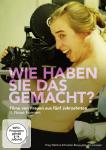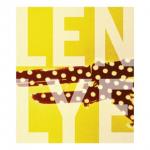"Film should not be misused for non-filmic messages": Wilhelm and Birgit Hein examine in their films theprocess of reproduction and the film material itself. Rohfilm shows the destruction of the common "film image" and was described by Stephen Dwoskin as a "visual bombing" of shreds, fragments, dirt and leftovers of film editing. Reproductions dissolves photos in greys, 625 films a negative "snow" TV image with different speeds, in Portraits photos are changed by the development and reproduction processes. Materialfilme consists of film starting and ending leaders, the elements of every film that normally are not seen on the screen. W+B Hein's underground film classics deal with the unexplored potentials of the film material which starts to disappear in the digital world.
"Film should not be misused for non-filmic messages": Wilhelm and Birgit Hein examine in their films theprocess of reproduction and the film material itself. Rohfilm shows the destruction of the common "film image" and was described by Stephen Dwoskin as a "visual bombing" of shreds, fragments, dirt and leftovers of film editing. Reproductions dissolves photos in greys, 625 films a negative "snow" TV image with different speeds, in Portraits photos are changed by the development and reproduction processes. Materialfilme consists of film starting and ending leaders, the elements of every film that normally are not seen on the screen. W+B Hein's underground film classics deal with the unexplored potentials of the film material which starts to disappear in the digital world.
For their 35mm Materialfilme (1976), the Heins randomly spliced together a mix of color and black and white material taken from the header and footer of commercial films. The scratches, scribbles, hand-written and commercially printed numbers and dots that adorn such footage rush past the eye until they are replaced by images consisting only of washed-out colors or scratched black and white frames. The Heins acquired this material during their years as programmers and projectionists for various avant-garde and commercial film screenings. In the 1960s and '70s, colors were often painted onto the header and footer of commercial films, so as to aid the projectionist in ordering the different reels. Over the years, this watercolor paint has faded and cracked, and various blotches, scratches and other irregularities have scarred the surface of the filmstrips. In projection, these marks on the material enter into arbitrary rhythmic relationships with the movement of color and the interrupting flashes of white light. Materialfilme thus offers a lush, visual symphony of the textures, the visible liquidity (emphasized by the watercolors), and the colors that mark the usually overlooked or unseen beginnings and endings of films.
While Materialfilme marks the conclusion of the Heins' immensively productive ten-year period of material filmmaking, this digital reproduction of these five important and underknown films represents a new beginning. The availability of these films on DVD ensures, of course, that knowledge about the Heins' significant artistic achievements will more easily reach a broader audience. Moreover, this digital reproduction puts the films literally in people's hands to screen in a variety of contexts and to score with different soundtracks. In this spirit, the DVD offers a variety of soundtracks, including the original one, composed specifically as accompaniment to Materialfilme (1976).
In conclusion, it's worth emphasizing once again the Heins' steadfast interestthroughout and after their period of collaborationin the aesthetic and perceptual effects enacted upon an original through the pro cesses of reproduction, whether analog or digital. Concurrently with their cinematic installation, "Film Space", at the Museum of Lucerne in May 1970, Christian Michelis, for instance, conducted an action that anticipates one of the possibilities of contemporary digital technology exploited on this DVD. I would like to bring this text to a close by quoting from Michelis's description of "Action Film and Sound": "The different effects of film made possible by the selective combination with various soundtracks. In the action room several audio tapes with different sound tracks play simultaneously during the projection of a film. By operating a mixing board, the audience can select single tracks and contrast them with the film for any length of time."
- Rohfilm 1968, 20'
- Reproductions 1968, 28'
- 625 1969, 34'
- Portraits 1970, 15'
- Materialfilme 1976, 35'
- Alternative scores by Tim & John Blue, Sister Iodine, Starving Weirdos, Roel Meelkop
- 20 page Booklet with essays by Marc Siegel and Florian Cramer











Añadir nuevo comentario